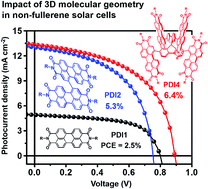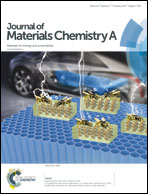Control of the molecular geometry and nanoscale morphology in perylene diimide based bulk heterojunctions enables an efficient non-fullerene organic solar cell†
Abstract
Herein we present the design of three perylene diimide (PDI) derivatives with different molecular geometries; namely the monomeric PDI1, the bay-linked PDI2 dimer, and the bay-linked PDI4 tetramer with a 9,9′-spirobifluorene core that are utilized as electron acceptors in non-fullerene organic solar cells (OSCs). In all cases the PTB7-Th polymer is used as the electron donor. Among the three PTB7-Th:PDI systems, the highest power conversion efficiency (PCE) is obtained by the PDI4-based OSC device that exhibits a maximum PCE = 6.44% followed by the PDI2-based (PCE = 5.32%) and PDI1-based (PCE = 2.48%) devices. The detailed study of the photoluminescence quenching, morphology and temperature-dependent charge transport properties of the three systems reveal that the highest PCE of PTB7-Th:PDI4 is a consequence of the three-dimensional (3D) molecular architecture of PDI4 that tunes energetic disorder in the PDI phase and contributes to the improvement of electron transport. Transient photovoltage characterization experiments further identify that the actual effect coming from the 3D molecular geometry of the PDI4 acceptor on PCE is the minimization of non-geminate charge recombination losses. This study provides updated guidelines for optimizing further the molecular structure of 3D small molecular electron acceptors that can be used in highly efficient non-fullerene OSCs.



 Please wait while we load your content...
Please wait while we load your content...